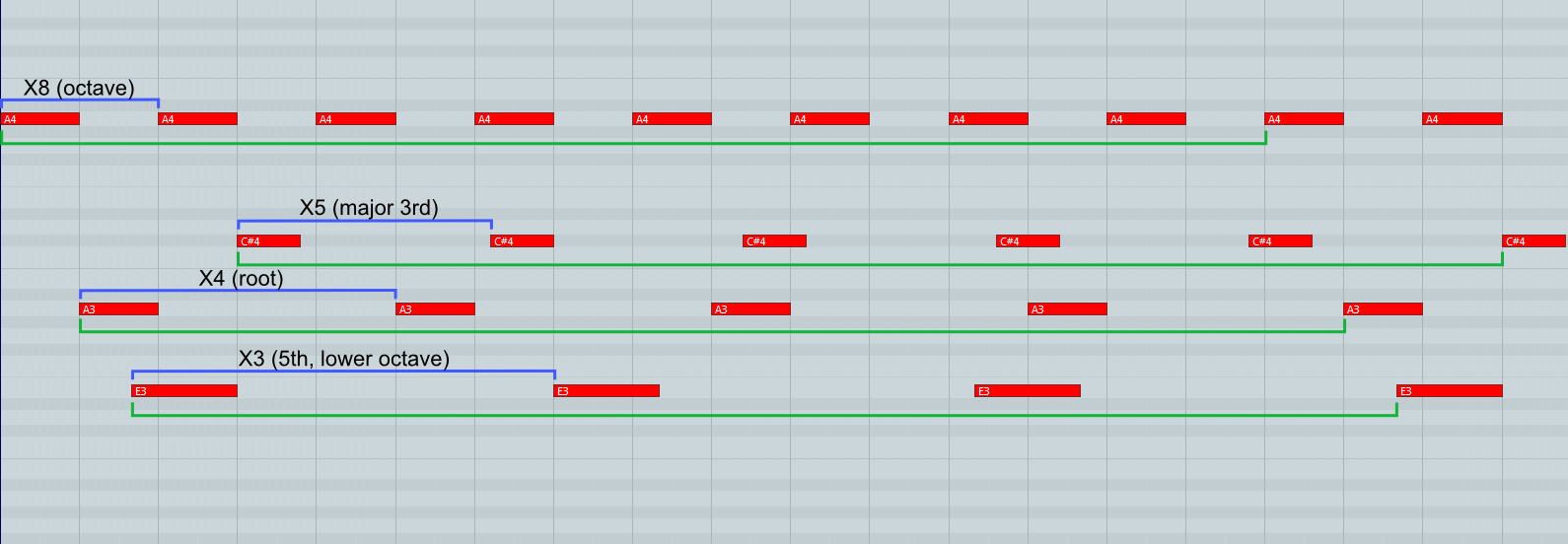Translational Frames
The first Pete P song released in roughly three years, “Translational Frames” was a bit painful to write and record, due to both lack of time and motivation. Despite my grievances, the tune is pretty cool conceptually—derived from some ideas on how to relate harmony to rhythm.
Rhythmic harmony
The bells and wood percussion parts in this song use a scheme that could be called “rhythmic harmony.” This was inspired by the fact that frequency—having units of events per unit time—can measure not just pitch, but any recurring event, including rhythmic ones. For pitches or tones, the “event” is the relatively fast vibration of a string, speaker, ear drum, etc. For example, a concert-A vibrates 440 times per second (440 Hz). A rhythmic frequency on the other hand could be hitting a snare drum every quarter note at 60 BPM, i.e. one hit per second (1 Hz).
Rhythmic harmony is constructed like harmony between pitches, i.e., by simultaneously playing rhythmic events at certain frequency ratios. For example, to create the rhythmic interval of a fifth (in just intonation), one multiplies a root frequency by 3/2. Therefore if a snare drum was playing quarter notes while the kick was playing dotted eighth notes, the resulting rhythmic pattern would be analogous to a “power chord.”
Rhythmic harmony in the woods
 Figure 1: Keyroll for the wood percussion part.
Figure 1: Keyroll for the wood percussion part.
The wood blocks use a “root rhythm” or interval based on a pattern that repeats itself every 7 16th notes, which was loosely taken from the rhythm of the guitar part. The harmonic analogy here is best understood by considering 7 as the period (the inverse of frequency) of the rhythmic pattern. Another rhythmic pattern is layered on top that lasts 7 32nd notes. This is a halving of the period and therefore doubling of the frequency, which gives us the octave of the root rhythm. On top of that is another rhythmic pattern (single hits) repeated with a period 4/5 of the octave, which is a frequency 5/4 times the octave, i.e., the major 3rd. See Figure 1 for an illustration.
Self-similar rhythmic harmony in the bells
 Figure 2: Keyroll for the bells.
Figure 2: Keyroll for the bells.
In addition to having harmonic ratios between the frequencies of the bells’ (coming in at 0:36) rhythms, the pitches of each are proportional to the rhythmic intervals, creating what could be called “self-similar rhythmic harmony.” In other words, the rate at which each bell is struck is a much much much lower octave of the frequency at which it vibrates.
The bells form a self-similar rhythmic major triad (with an inverted 5th). In Figure 2 the green brackets mark off equal lengths of time, visualizing how many bell hits fit into—and therefore the striking frequency of—each note. Despite being composed in such a soulless, analytical manner, I actually think the way the rhythms and pitches overlap in different parts of the cycle sounds pretty cool.
Self-similarity in the tempo
A tempo is also measured in units of frequency. Semi-coincidentally, the tempo of this song (154.6875 BPM) is a super super low octave of the fifth in the key of A, so to speak, which can be calculated as
\[110 \frac{\mathrm{cycles}}{\mathrm{second}} \times \frac{3}{2} \times 60 \frac{\mathrm{seconds}}{\mathrm{minute}} \div (2^6) = 154.6875.\]A harmonic tempo change
At 2:41 there is a tempo change, which was added to get the subsequent part to “feel right.” The period of the pulse or click track changes to 4 X 1/8 quintuplets, effectively increasing the tempo by a factor of 5/4, i.e. shifting up a major 3rd from the original.
So, as you can see there are a couple shallow layers of theoretical foolishness, which probably don’t contribute much to the listening experience. Hopefully they are at least somewhat fun for you to think about!
Gear
- Guitar: Agile Sentinel 725 with Lollar Special (bridge) and Blonde (neck) pickups, tuned to A-standard “top-biased” (A, D, G, C, E, A, D)
- Amp: Peavey Revalver
- Drums: Superior Drummer 2.0
The lyrics
Climbed atop the tiny hill
Sitting in the shadow of the mountain
Now groaning slowly dying
Halfway made of stone
That’s the key
Had one chance to set the boundary
Became the ghost
Appeared on toast
L-O-STea helps climb those steep walls
And when you hit them beans
You’ll grind them all
[Get the fuck out now]Oh the roads and wondering how far they go
So sorry but I’m not home now
Livin’ in a groove in a grove
Since I dove
Along the sea
Salt in synchronicity
Pendulum swingin’ out and seekin’ a healthy fruitin’ tree
I lost a peel
My orangeryRe-seasoned to my taste
[Just an egg
Get to the hatch
Gotta make me up another batch]
Ants swarm on my base
[Get the fuck out now]Lost
Box of cracker jacks of all trades
Am I wasting thyme now
To stay
Less than al denteRot, when you tell me
Look you just got to stay
Neglecting produce expired on display
Bad one in a bunch
No lunch!
No whey!
That plants the seed for the translational frameThought it was ready to serve
Still way down there on that curve
Facing in dread the new step
Turns out the god damned bacon bread was only the fucking prep!I done had to translate my ass
Just had to get me mise en place
It done sucked choking on chocolate rain
No marrow left in the bone
Just face it
I was never even home
Lynx
© 2025 Pete Peterson. All rights reserved.